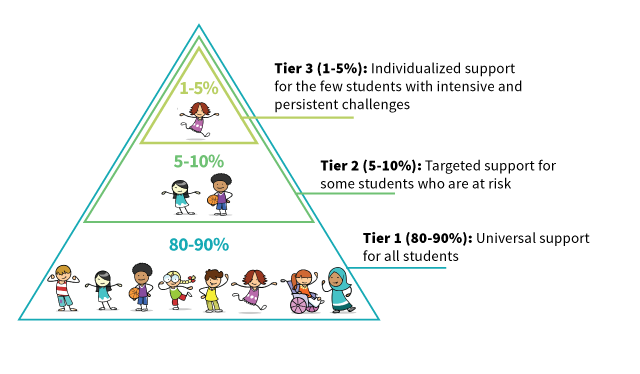Positive Behavior & Discipline Support

MTSS stands for multi-tiered systems of support. It is a framework to provide academic and behavioral supports for all students based on their individual needs. Because different students have different strengths and needs, tailored levels of support are more likely to help them succeed in school. “Multi-tiered” generally refers to three tiers that correspond to different intensities of the support.
Tier 1
Tier 1, or school-wide support, is provided as the foundation of the “pyramid of support” to all students. In an MTSS framework, Tier 1 supports are intended to prevent challenges from occurring in the first place. As such, this involves teaching critical skills and behaviors that all students are expected to learn. For example, students learn core academic content through high quality evidence-based instruction in the classroom along with universal screening and progress monitoring. School staff also teach students clear rules and expectations for behaviors in and out of the classroom. In a school that is effectively implementing these school-wide supports it is estimated that a majority of students (80-90%) will respond positively. For example, this means that if there are 100 total students at Cheremoya Elementary School, about 80-90 students will follow school rules and respond well to general classroom instruction.
Tier 2
This leaves about 10-20 students who may need more support to be successful. These students may exhibit difficulties with learning specific academic content or following rules more often than their peers, causing delays in instruction and/or behavior problems. For these students, school staff can provide more focused, or “Tier 2” supports, which are more specialized or targeted intervention programs. Typically, these targeted programs are provided in small group settings, which may involve increased time dedicated to instruction or more intensive methods of instruction. For example, students may receive differentiated instruction matched to their needs based on screening or progress monitoring data for a specific subject, or increased opportunities for instruction and feedback on the school rules and expectations (through an intervention called “Check in Check out”). We might predict, based on our example with our students at Pyramid Elementary School, that about 5-10 students would respond well to these targeted supports—helping them to improve their academic and/or behavior challenges.
Tier 3
Now what about the few remaining students at Cheremoya Elementary who don’t respond effectively to Tier 1 or Tier 2 supports? These students may need more intensive Tier 3 supports at the top of the pyramid. Usually these students, with serious and chronic needs, will receive individualized services from specialists, such as the school counselor, psychologist, behavioral specialist, and/or instructional specialist—or even from outside services, such as community practitioners.
This type of multi-tiered framework puts processes in place to identify, support, and monitor the progress of students using the best data and evidence available, to make sure students’ levels of support match their levels of need.
